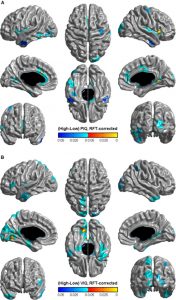Neuroimage. 2017 Jan 1;144(Pt A):227-240. doi: 10.1016/j.neuroimage.2016.08.041. Epub 2016 Aug 21.
Khundrakpam BS1, Lewis JD2, Reid A3, Karama S2, Zhao L2, Chouinard-Decorte F2, Evans AC2; Brain Development Cooperative Group.
Author information
- McConnell Brain Imaging Centre, Montreal Neurological Institute, McGill University, Montreal, Canada. Electronic address: budha@bic.mni.mcgill.ca.
- McConnell Brain Imaging Centre, Montreal Neurological Institute, McGill University, Montreal, Canada.
- Institute of Neuroscience and Medicine (INM-1), Research Centre Jülich, Jülich, Germany.
Abstract
Verbal and non-verbal intelligence in children is highly correlated, and thus, it has been difficult to differentiate their neural substrates. Nevertheless, recent studies have shown that verbal and non-verbal intelligence can be dissociated and focal cortical regions corresponding to each have been demonstrated. However, the pattern of structural covariance corresponding to verbal and non-verbal intelligence remains unexplored. In this study, we used 586 longitudinal anatomical MRI scans of subjects aged 6-18 years, who had concurrent intelligence quotient (IQ) testing on the Wechsler Abbreviated Scale of Intelligence.
Structural covariance networks (SCNs) were constructed using interregional correlations in cortical thickness for low-IQ (Performance IQ=100±8, Verbal IQ=100±7) and high-IQ (PIQ=121±8, VIQ=120±9) groups. From low- to high-VIQ group, we observed constrained patterns of anatomical coupling among cortical regions, complemented by observations of higher global efficiency and modularity, and lower local efficiency in high-VIQ group, suggesting a shift towards a more optimal topological organization. Analysis of nodal topological properties (regional efficiency and participation coefficient) revealed greater involvement of left-hemispheric language related regions including inferior frontal and superior temporal gyri for high-VIQ group. From low- to high-PIQ group, we did not observe significant differences in anatomical coupling patterns, global and nodal topological properties. Our findings indicate that people with higher verbal intelligence have structural brain differences from people with lower verbal intelligence – not only in localized cortical regions, but also in the patterns of anatomical coupling among widely distributed cortical regions, possibly resulting to a system-level reorganization that might lead to a more efficient organization in high-VIQ group.
Crown Copyright © 2016. Published by Elsevier Inc. All rights reserved.



